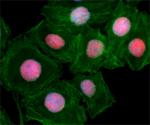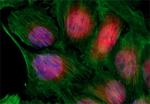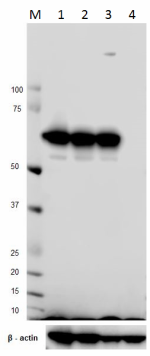- Clone
- P81C12B8 (See other available formats)
- Regulatory Status
- RUO
- Other Names
- Serine/threonine-protein kinase Chk2, CHK2 checkpoint homolog, Hucds1, Checkpoint kinase 2
- Isotype
- Mouse IgG2b, κ
- Ave. Rating
- Submit a Review
- Product Citations
- publications

-

Total lysates (10 µg protein) from HeLa and HeLa Chk2 CRISPR/Cas9 knockout (KO) cells were resolved by electrophoresis (4-20% Tris-glycine gel), transferred to nitrocellulose, and probed with 1:500 (1 µg/ml) purified anti-Chk2 antibody , clone P81C12B8 (upper). Proteins were visualized using chemiluminescence detection by incubation with HRP goat anti-mouse-IgG secondary antibody (Cat. No. 405306). Direct-Blot™ HRP anti-β-actin Antibody (Cat. No. 643807) was used as a loading control (lower). Lane M is the Molecular weight ladder. Chk2 has 13 isoforms, this antibody might recognize some of them. -
Total cell lysates (15 µg protein) from NB-4 (lane 1), Molt-4 (lane 2), HeLa (lane 3) and NIH3T3 (lane 4) cells were resolved by electrophoresis (4-12% Bis-Tris gel), transferred to nitrocellulose, and probed with 1 µg/mL (1:500 dilution) of purified anti-Chk2 antibody (clone P81C12B8) (upper panel). Proteins were visualized by chemiluminescence detection using a 1:3000 diluted anti-mouse-IgG secondary antibody conjugated to HRP for anti-Chk2 antibody or 1:5000 diluted Direct-Blot HRP anti-β-Actin antibody, clone 2F1-1(lower panel) as a loading control. Lane M: Molecular weight ladder. -

HeLa cells were fixed with 2% paraformaldehyde (PFA) for 15 minutes, permeabilized with 0.5% Triton X-100 for three minutes, and blocked with 5% FBS for 60 minutes. Then the cells were intracellularly stained with 2 µg/ml anti-CHK2 antibody (clone P81C12B8) overnight at 4°C followed by Alexa Fluor® 594 (red) conjugated goat anti-mouse IgG for one hour at room temperature. Actin filaments were labeled with Alexa Fluor® 488 Phalloidin (green). Nuclei were counterstained with DAPI (blue). The image was captured with a 60X objective.
Chk2 was discovered in 1998 as the mammalian homolog of Saccharomyces cerevisiae Rad53 that is active in the yeast DNA damage response (DDR). The protein is conserved in mouse, rat, zebrafish, Xenopus laevis, Drosophila melanogaster, and Caenorhabditis elegans. In humans, it is a single 65 kD polypeptide of 543 residues with three distinct functional domains. During normal growth, Chk2 is present in the nucleus in an inactive monomeric form. After DNA damage, Chk2 is phosphorylated by ATM, which induces Chk2 dimerization and autophosphorylation. When activated, Chk2 phosphorylates nuclear proteins involved in many aspects of the DDR. Many of the Chk2 substrates fall into one of four functional groups involved in DNA repair, cell cycle regulation, p53 signaling, and apoptosis. Chk2 degradation is independent of its activation, its kinase activity, and its phosphorylation state. Chk2 stability is regulated by the E3 ubiquitin ligase SIAH2, which regulates Chk2 basal turnover, with important consequences on cell-cycle control and on the ability of hypoxia to alter the DNA damage-response pathway in cancer cells. In cancers, Chk2 primarily plays roles as tumor suppressor. It negatively regulates androgen sensitivity and prostate cancer cell growth dependent on the downstream signaling proteins CDC25C and Chk1. Chk2 –BRCA1 axis restrains oncogenic Aurora-A activity during mitosis. Chk2-mediated phosphorylation of BRCA1 is required to recruit the PP6C–SAPS3 phosphatase, which acts as a T-loop phosphatase inhibiting Aurora-A bound to BRCA1.
Product DetailsProduct Details
- Verified Reactivity
- Human
- Antibody Type
- Monoclonal
- Host Species
- Mouse
- Immunogen
- Purified recombinant fragment of Chk2 (AA: 481-531) expressed in E.Coli.
- Formulation
- Phosphate-buffered solution, pH 7.2, containing 0.09% sodium azide.
- Preparation
- The antibody was purified by affinity chromatography.
- Concentration
- 0.5 mg/ml
- Storage & Handling
- The antibody solution should be stored undiluted between 2°C and 8°C.
- Application
-
WB - Quality tested
ICC, KO/KD-WB - Verified - Recommended Usage
-
Each lot of this antibody is quality control tested by Western blotting. For Western blotting, the suggested use of this reagent is 0.25 - 1.0 µg/ml. For immunocytochemistry, a concentration range of 1.0 - 5.0 μg/ml is recommended. It is recommended that the reagent be titrated for optimal performance for each application.
- RRID
-
AB_2616885 (BioLegend Cat. No. 686602)
Antigen Details
- Structure
- 543 amino acid with a predicted molecular weight of 61 kD. There are 13 predicted isoforms with MW ranging from 15 to 65KD (15, 17, 19, 23, 24, 26, 32, 36, 38, 50, 58, 61, 65kD, respectively).
- Distribution
-
Nucleus.
- Function
- Involved in checkpoint-mediated cell cycle arrest, activation of DNA repair and apoptosis in response to the presence of DNA double-strand breaks.
- Interaction
- Homodimer. Interacts with PML, TP53, RB1, BRCA1, MDC1, TP53BP1, CDC25A, CUL1, CDKN2AIP, CCAR2, and SIRT1.
- Biology Area
- Apoptosis/Tumor Suppressors/Cell Death, Cell Biology, Cell Cycle/DNA Replication
- Antigen References
-
1. Zannini L, et al. 2014. J. Mol. Cell Biol. 6:442.
2. Matsuoka S, et al. 1998. Science 282:1893.
3. Ahn JY, et al. 2000. Cancer Res. 60:5934.
4. García-Limones C, et al. 2016. Oncogene. doi:10.1038/onc.2015.495.
5. Ta HQ, et al. 2015. Cancer Res. 75:5093.
6. Ertych, et al. 2016. Proc. Natl. Acad. Sci. USA 113:1817. - Gene ID
- 11200 View all products for this Gene ID
- UniProt
- View information about Chk2 on UniProt.org
Other Formats
View All Chk2 Reagents Request Custom Conjugation| Description | Clone | Applications |
|---|---|---|
| Purified anti-Chk2 | P81C12B8 | WB,ICC,KO/KD-WB |
| Alexa Fluor® 594 anti-Chk2 | P81C12B8 | ICC |
Compare Data Across All Formats
This data display is provided for general comparisons between formats.
Your actual data may vary due to variations in samples, target cells, instruments and their settings, staining conditions, and other factors.
If you need assistance with selecting the best format contact our expert technical support team.
-
Purified anti-Chk2

Total lysates (10 µg protein) from HeLa and HeLa Chk2 CRISPR... 
HeLa cells were fixed with 2% paraformaldehyde (PFA) for 15 ... Total cell lysates (15 µg protein) from NB-4 (lane 1), Molt-... -
Alexa Fluor® 594 anti-Chk2

HeLa cells were fixed with 4% paraformaldehyde (PFA) for 15 ...









Follow Us